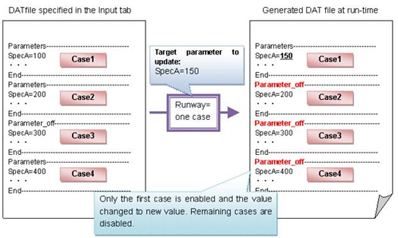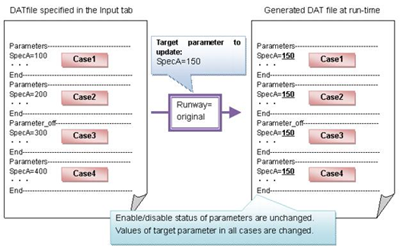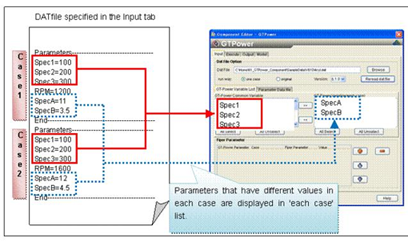Selecting the Input File and Parameters | ||
| ||
Double-click the GT-POWER component icon
 .
.The GT-POWER Component Editor appears.
From the GT-POWER Component Editor, click the Input tab.
Click Browse to specify the input file containing the input parameters.
Navigate to the GT-POWER input (.dat) file that you want to use, and click Open.
Specify the Run Way options:
- Select One Case to map the parameters in the first case of the input (.dat ) file to Isight. You can edit the values of all the parameters in Isight.

- Select Original to map the parameters in cases marked as to run in the input (.dat) file to Isight. In this case, you can only change those parameter values that are common among all cases. Values that are not common among cases are taken from the input .dat file.
You can choose which output values to use by selecting cases from the Case Options field in the Output tab.

- Select One Case to map the parameters in the first case of the input (.dat ) file to Isight. You can edit the values of all the parameters in Isight.
Click Read Dat File.
The GT-POWER Variable List subtab is populated with the parameters and the Parameter Data File subtab is populated with the parameter data files present in the input (.dat) file.

In the GT-POWER Variable List subtab, the GT-POWER Common Variable list is populated with parameters that have common values across all cases and the GT-POWER Variable (each case) list is populated with parameters that have different values across cases.
The GT-POWER Variable (each case) option is disabled when Original is selected as the Run Way option.

The name of the Read Dat File button changes to Reread Dat File. Click Reread Dat File if you wish to read the input .dat file again.
Click
 to move the selected variable from the GT-POWER Common Variable list to the GT-POWER Variable (each case) list, or click
to move the selected variable from the GT-POWER Common Variable list to the GT-POWER Variable (each case) list, or click  to move the selected variable from the GT-POWER Variable (each case) list to the GT-POWER Common Variable list.
to move the selected variable from the GT-POWER Variable (each case) list to the GT-POWER Common Variable list.When a variable is moved from the GT-POWER Common Variable list to the GT-POWER Variable (each case) list, the case number and the parameter value get appended with the parameter name. For example, the name of the parameter DXE will change to DXE-case1-25, where case1 is the case number and 25 is DXE's value.
When a variable is moved from the GT-POWER Variable (each case) list to the GT-POWER Common Variable list, the case number and the value get removed from the name. For example, the name of the parameter HC_CONCENTRATION_case1_3.65811 will change to HC-CONCENTRATION.
Select the input parameters you want to use by doing any of the following:
Option Description Click the parameter Select an individual parameter. Select All Select all the parameters. Unselect All Clear all the selected parameters. Add the selected parameters to the Isight Parameter area.
Click
 to add the selected parameters to Isight Parameter area.
to add the selected parameters to Isight Parameter area.Click
 to remove the selected parameters from the Isight Parameter area.
to remove the selected parameters from the Isight Parameter area.In the Isight Parameter area, the name of the parameter in GT-POWER is displayed in the GT-POWER Parameter column and the name of the parameter in Isight is displayed in the Isight Parameter column. Additional parameter details such as the Case and Value are also displayed.
The variables added to the Isight Parameter area can be used in your Isight model. The parameter RPM is not shown in the Isight Parameter area but is automatically added as an Isight parameter.
If desired, edit the Isight Parameter Name and Value.
Click
 to move the selected parameter up in the table, or click
to move the selected parameter up in the table, or click  to move the selected parameter down in the table.
to move the selected parameter down in the table. Click the Parameter Data File subtab.
The parameter data files present in the input .dat file are displayed.
By default, all the parameter data files are selected and can be used in your Isight model. However, if you do not want to use any parameter data file in your Isight model, clear the corresponding check box.
Click OK to save your changes and to return to the Design Gateway.